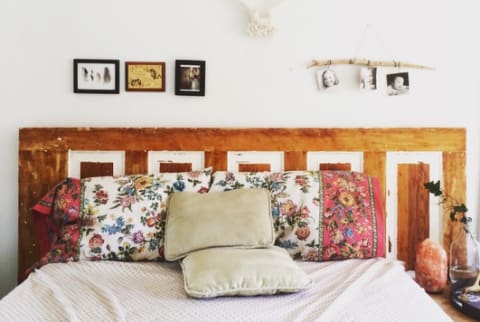Advertisement
I’m a Sleep Expert. Here's The Nighttime Routine That Lulls Me Into Slumber Every Time


You might think the doctor who treats everybody else's sleep problems would be a "holier than thou sleeper," but now it's time for a moment of truth. Anybody out there who knows me has probably seen me stay out until 4 a.m., sleep in to 11 a.m., or embark upon a house organization project at midnight. I did not come into this world as a 10 p.m. to 6 a.m. picture-perfect sleeper. It's quite the opposite: I'm the preacher who has sinned. But as a notorious sleep procrastinator and night owl dealing with racing thoughts at bedtime, I've had to work hard at cracking the sleep code. This struggle has forced me to understand the barriers to sleep, and now I can better understand how to help my patients. Here are a few tips that have helped me so far, plus a "night in the life."
To figure out your evening sleep schedule, always start with the morning.
What time does the alarm go off? Once upon a time, my alarm went off at 7:50 a.m. These days my baby is my alarm clock, and she goes off without fail around 6:45 a.m. I need a full eight hours of sleep to feel my best. So I count back eight hours from 6:45 a.m., and this means I need to be asleep by 10:45 p.m. And that’s not getting into bed at 10:45 p.m.; that’s asleep. For this to work, I need to be in bed reading by 10:30 p.m. 10:30 p.m.?!? This is a far cry from staying out dancing till 4 a.m. Which reminds me...acceptance is an important part of getting on the right sleep schedule. I now know that if I get in bed any later than 10:30 p.m., it hurts in the morning. Not worth it. So I accept reality and stick to this wholesome early schedule.
Design your wind-down routine.
To be in bed by 10:30 p.m., I need to shut down electronics around 9 p.m. This is a nonnegotiable. Having electronics open after 9 p.m. is effectively taking a shot of espresso at bedtime. The blue light from computer, phone, and TV screens fools the brain into thinking it’s daytime, basically sending a message to your brain: "Wakey, wakey, eggs and bakey."
Beyond the blue light, the content of electronics is also not conducive to sleep. Whether it's the stress of work email, the adrenaline of shows like Game of Thrones, the addictive quality of video games, or the disorientation of going down internet rabbit holes, it creates a hormonal cascade in your body that's destructive to sleep.
A night in the life of a sleep expert.
6 p.m. to 7 p.m.: Put the baby down to sleep.
Put baby down to sleep. As we're getting her ready for bed, we have the shades wide open and we don't turn on any artificial lights. The light of the setting sun is like information, cuing her that it's dusk and time to feel sleepy. In the winter, when it's completely dark by 7 p.m., we use candles to see.
7:30 p.m.: Proceed with dinner, work, exercise, and TV.
After the baby is down, I'd love to say my husband and I continue with candlelight, meditation, and synchronized Gregorian chant in darkness until we drift off to sleep by a wholesome 8:30 p.m., but that is not the case. We turn on some lights (though not full blast) and proceed with dinner, exercise, finishing work, and (gasp!) TV.
9:30 p.m.: Turn down the apartment.
Beginning around 9:30 p.m., my apartment turns into a Boyz II Men music video: dim lights, candles, soothing music. Are there nights when I stray from this? You bet, but I pay the price with poor-quality sleep.
10 p.m.: The wind-down begins, including a magnesium regimen.
By 10 p.m., I’m officially winding down for sleep. If I needed to discipline myself, I'd have a gentle alarm sound go off to signal it's time to get ready for bed. There are basically no more lights on in the house at this point. I take a shower and brush my teeth by candlelight. When the cosmos align, which is about once a week, I manage to take an Epsom salt bath. Magnesium is a mineral that relaxes your muscles and your mind, and Epsom salts are basically a surround-sound, full-body magnesium delivery system. When I take a bath, I fall asleep more easily and my sleep feels deeper. On nights when I don't take a bath, I take about 400 milligrams of magnesium glycinate before bed.
10:15 p.m.: Practice gratitude and prepare the bedroom.
When I enter the bedroom, I draw my blackout shades and set the thermostat to 65 degrees (optimal temperature to promote deep sleep). If the outside temperature is in that range, I skip the A/C and sleep with the windows open—mother nature's air conditioner.
Sometimes I'll do a gratitude practice before bed. There's nothing fancy about this—it usually means my husband and I each list the things we're grateful for from that day.
By 10:30 p.m. I'm in bed reading. Full disclosure: I wear orange plastic glasses to block out any blue light. Don't worry, they're very sexy. Sometimes I read on a backlit Kindle, and other times I read a paper book, using a salt lamp as my light. Either way, I wear the glasses. I avoid stressful or work-related books at bedtime.
10:45 p.m.: Time for bed, finally.
Once I feel sleepy, I put the book aside and go to sleep. Even though we have blackout shades installed, I actually still wear an eye mask to achieve complete darkness.
~ 3 a.m.: The wake-up solution.
If I wake up in the middle of the night, I'll assess what my body seems to need. Sometimes I just need a sip of water or a pit stop. I have an orange night light set up in the bathroom to avoid having to turn on any lights. If I'm hungry or headachy, a little blood sugar support is what my body needs to fall back asleep. I keep a jar of coconut oil and a spoon next to my bed, and I take a spoonful, barely even opening my eyes, then lie back down. If I'm stressed, I'll place my hands on my stomach and do deep belly breathing, or I'll do a body scan until I fall back asleep. If I'm stressed and my mind is racing, I cut my losses: I turn on the salt lamp, put on the orange glasses, get out a pen and paper, and write out a list of what's on my mind. Sometimes this is the only way to quiet my mind. Once I get everything down on paper, I go back to sleep easily.
6:45 a.m.
Baby coos. It's a beautiful morning.

Ellen Vora, M.D. is a board-certified psychiatrist, acupuncturist, and yoga teacher, and she is the author of the No. 1 bestselling book The Anatomy of Anxiety. She takes a functional medicine approach to mental health—considering the whole person and addressing imbalance at the root. Vora received her B.A. from Yale University and her M.D. from Columbia University.

Ellen Vora, M.D. is a board-certified psychiatrist, acupuncturist, and yoga teacher, and she is the author of the No. 1 bestselling book The Anatomy of Anxiety. She takes a functional medicine approach to mental health—considering the whole person and addressing imbalance at the root. Vora received her B.A. from Yale University and her M.D. from Columbia University.